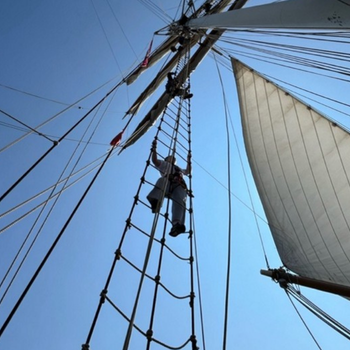Final-year medical student Ellie Rowbotham swaps scrubs for sea boots as she reflects on her first voyage as a sail trainee during the Tall Ships Races in Aberdeen.
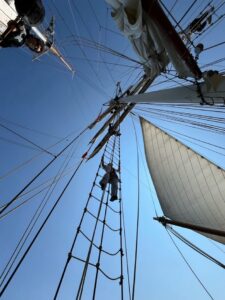 What is a tall ship? As someone who had not sailed before, when I heard about the Tall Ship Race I was asking myself the same thing! According to google a Tall Ship is a traditionally rigged sailing vessel. To me – they’re just big!
What is a tall ship? As someone who had not sailed before, when I heard about the Tall Ship Race I was asking myself the same thing! According to google a Tall Ship is a traditionally rigged sailing vessel. To me – they’re just big!
So why did I compete? In 2024 I saw an advert on Facebook and booked a free taster Tall Ship session in Aberdeen. Young people from Aberdeen were encouraged to apply as a sail trainee through Aberdeen City Council. They were then allocated from either Dunkirk to Aberdeen or Aberdeen to Kristiansand (Norway).
Trainees ranged from ages 15 to 25. My ship consisted of trainees from Aberdeen, Orkney, Kristiansand, Esbjerg, Poland, Ireland, Germany and more! Many of the international trainees had already sailed on the ship as part of the High Seas High School (a year of school on a tall ship) which was incredibly useful when stuck tying knots!
My ship
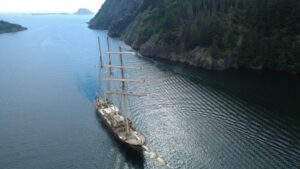
I sailed on the Gulden Leeuw (the golden lion in Dutch). The Gulden Leeuw was built in 1937 and was used as a research vessel until 1980. It is one of the world’s largest three-mast-topsail schooners and sails under the Dutch flag. The ship is now used for high sea education which involves students living on the ship and having classes from teachers onboard.
Crossing the North Sea
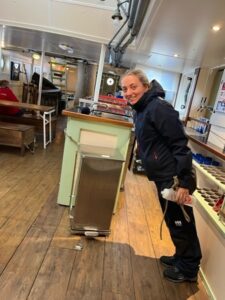 I was very hesitant to sail across the North Sea as I’m aware of how choppy it can get. I was very surprised when I woke up for watch and the boat was heeling at 30 degrees. This made walking along the boat very hard and I often needed help to open doors to the deck.
I was very hesitant to sail across the North Sea as I’m aware of how choppy it can get. I was very surprised when I woke up for watch and the boat was heeling at 30 degrees. This made walking along the boat very hard and I often needed help to open doors to the deck.
The rocking of the boat also meant that many trainees suffered from sea sickness. Although counterintuitive, we were advised to continue to eat three large meals a day as this supposedly allows you to know which way is down. Sea sickness also made me feel incredibly tired. Despite this, I did enjoy being rocked to sleep in my bunk at night and slept incredibly well.
The race
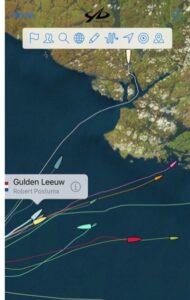 Our sail consisted of a race from Aberdeen to (near) Kristiansand. The ship was in the class A, meaning we competed against some very large ships!
Our sail consisted of a race from Aberdeen to (near) Kristiansand. The ship was in the class A, meaning we competed against some very large ships!
We completed the race in 1 day 9 hours 35 minutes and 30 seconds, coming 7th in class A and 10th overall. Nearly fifty boats competed in the race.
The race was followed by a cruise in company along the Norwegian coast with nights on anchor and in ports with other ships. We later found that one of the other ships had a functioning sauna onboard!
Medicine on a ship
Whilst on the boat I spoke to the ship’s doctor. The ships need to have someone who has completed a first aid qualification but there is not a strict requirement for a medical doctor. The doctor told me that although ships are not required to have a doctor onboard, she thinks it is beneficial. More specifically, she stated that being able to insert cannulas to administer medications is beneficial. So keep practising your cannulas!
Whilst onboard, common injuries included cuts on rusty metal, rope injuries due to significant tension and wind in the sails and mental health episodes.
Whilst onboard I helped to perform an A-E when someone became unwell. After their recovery, I reflected on the remoteness of this doctor’s role and lack of a supporting medical team. This role relies on brisk initial management and decision making when choosing to come to shore or calling to get a medical evacuation.
The realities of life on board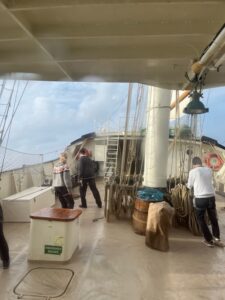
During the journey we were split into groups called watches. Each watch was either on (4 hours), off or on galley (cooking). Watch included navigation, sail handling, lookouts and steering. I found this a lot harder when watches were in the night. Although four hours long, watch was incredibly tiring and combined with sea sickness, this drained energy levels. Trainees were aided by the crew on the ship which included three deckhands, the captain, an engineer, bosun, doctor and cook.
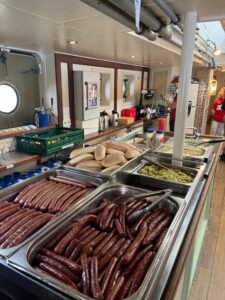
Galley duty (cooking breakfast and lunch or dinner for over 60 people) is something I had never expected myself to be a part of! Cutting pickles for an hour was also a tricky experience whilst the boat was moving! The ship’s chef had to keep a log of the food used, allowing him to track our supply and plan meals. Food waste could also be disposed of overboard when far enough offshore.
Sleeping arrangements
All trainees slept within the same room in bunks. These were surprisingly comfortable, but the room could be cold and noisy. A difficulty was ensuring all your belongings were sea-tight – mine were not and my poor bunkmate would return my lost items each morning!
As watches were awake at different times, no alarms were allowed. This meant part of watch duty was waking the next group by shaking their pillow 15 minutes before the start of their watch. Sleeping through meals was easily done. I was devastated when I slept through dinner one evening, but managed to find some leftovers in the fridge.
Bathrooms
Both sides of the ship had toilets and showers. Whilst the ship was on its side only the bathrooms on the lower side of the ship could be used as otherwise they could not drain. An hour was spent each day cleaning the ship, termed ‘happy hour’ allowing it to stay shipshape onboard.
WiFi
Whilst at sea we could get signal until around 20 miles offshore. We were warned to turn this off past 20 miles as you could connect to the WiFi of oil rigs we were passing and end up with a large bill.
Final thoughts
Whilst reflecting on this surreal experience, I conclude that being a complete beginner can be really rewarding. The enthusiasm of more experienced sailors was inspiring and jumping off the boat into Norway’s fjords after two days at sea is a feeling I will never forget.
As the race grew nearer I became anxious because of my lack of experience in sailing and crewing on a ship. But I am so glad that I pushed myself to take part and will hopefully compete again next year!
I would like to thank Tunnock’s and Macphie’s LTD for helping to sponsor my trip.

